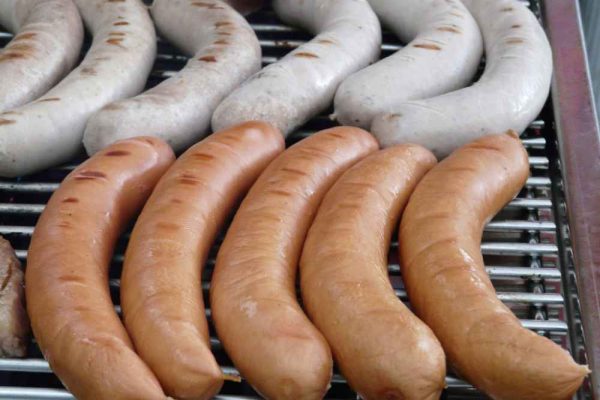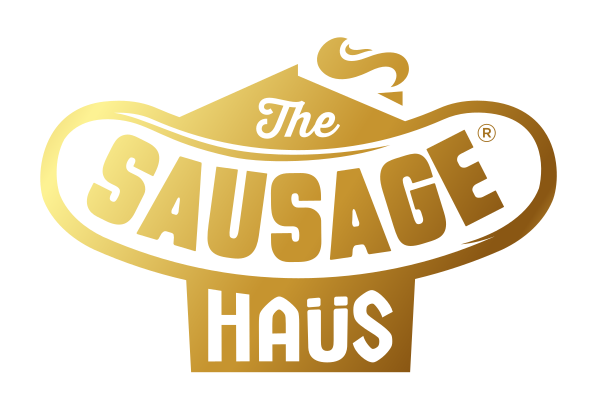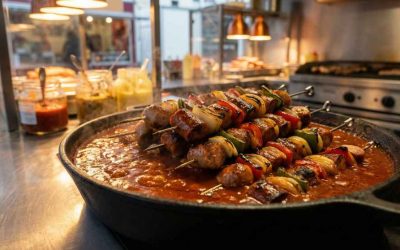Two Icons of German Flavour
Ask anyone to name a German sausage, and you’ll almost always hear the words Bratwurst and Frankfurter.
Both are beloved around the world — grilled at Oktoberfest, served at street markets, and enjoyed in pubs and restaurants across the UK.
Yet even among sausage lovers, many still wonder: What’s the real difference between Bratwurst vs Frankfurter?
At The Sausage Haüs, we craft both varieties using centuries-old German recipes, allowing us to explain exactly what sets these classics apart — and why each deserves a place on your menu.

Origins & Tradition
Bratwurst – The Rustic Classic
The name Bratwurst derives from the Old High German brät, meaning finely chopped meat. Records trace it back more than 700 years, particularly to Franconia and Thuringia in central Germany.
Traditionally made from pork, sometimes with veal, the Bratwurst was created as a farmhouse recipe — a way to use the freshest cuts of meat seasoned with salt, white pepper, marjoram, and nutmeg.
Today, the Sausage Haüs Bratwurst stays true to that heritage: coarsely minced, juicy, and lightly spiced to let the quality of the pork shine through.
Frankfurter – The Elegant Export
The Frankfurter originates from Frankfurt am Main, where butchers developed a finely textured sausage that later travelled the world as the forerunner of the hot dog.
Traditionally made from pork and beef, it’s smoked over beechwood to develop a delicate aroma and characteristic golden skin.
Our Cheese Frankfurter and Bacon Frankfurter build on this tradition, adding modern twists while keeping that same unmistakable German smoothness.

Ingredients and Texture
The main difference between Bratwurst and Frankfurter lies in the grind and preparation of the meat:
| Feature | Bratwurst | Frankfurter |
|---|---|---|
| Texture | Coarse and meaty | Smooth and finely emulsified |
| Flavour | Seasoned with marjoram, nutmeg, pepper | Strong, boldly smoked |
| Appearance | Pale, rustic, thicker | Uniform, shiny, golden |
| Cooking Method | Grilled or pan-fried | Heated gently or grilled |
| Serving Temperature | Often hot off the grill | Can also be enjoyed cold |
This contrast makes them ideal complements — the Bratwurst brings hearty bite and spice, while the Frankfurter delivers silky texture and subtle smokiness.
Cooking and Serving Styles
How to Cook Bratwurst
Bratwursts love the grill. Their coarser texture means a little browning enhances both aroma and bite.
They can also be pan-fried or gently heated in hot (not boiling) water for consistent results.
Serving Ideas:
- Traditional roll with mustard and sauerkraut
- “Currywurst” style with curry ketchup and fries
- Pub comfort food with mash and onion gravy
How to Cook Frankfurter
Frankfurters are usually pre-cooked and smoked, requiring only gentle reheating. Avoid boiling — instead, warm them in hot water (about 80 °C) or quickly on a grill to avoid splitting the casing.
Serving Ideas:
- Classic Hot Dog with ketchup and mustard
- Cheese Frankfurter topped with crispy onions
- Bacon Frankfurter wrapped and baked for buffets or events

For Caterers & Retailers in the UK
Both sausages are supplied pre-cooked, frozen, and vacuum-packed through Baird Foods, ensuring food-safety and consistent quality.
That means no raw handling, minimal waste, and quick preparation — ideal for:
- Pubs and restaurants needing quick-serve mains
- Event caterers at festivals or Christmas markets
- Retailers offering high-quality ready-to-heat German sausages
Whether you prefer the Bratwurst’s rustic bite or the Frankfurter’s smooth smokiness, both deliver authentic flavour with the reliability professionals expect.
Which One Should You Choose?
It depends on your menu:
- Choose Bratwurst if you want a bold, meaty, traditional sausage that pairs beautifully with mustard, onions, and potatoes.
- Choose Frankfurter if you want a smoother, milder sausage perfect for buns, buffets, and family appeal.
For most caterers and wholesalers, the ideal solution is to offer both. Together they create variety, cross-sell opportunities, and that unmistakable “taste of Germany” customers love.
If you’re a wholesaler, caterer, or retailer looking to offer these authentic German sausages on your menu, explore our full range and supply options here: German Sausages Wholesale UK.
Did You Know?
The first written record of the Bratwurst dates back to 1269 in Erfurt, while the Frankfurter earned legal protection as early as 1860.
Both now stand as official German regional specialities — proof that quality and tradition never go out of style.
Crafted by Masters – The Hardy Remagen Heritage
Behind both the Bratwurst and Frankfurter stands a name that defines German sausage excellence: Hardy Remagen
.
With over 300 years of butchery tradition, Remagen represents the gold standard in authentic German sausage production. Their recipes are rooted in centuries of craftsmanship, perfected through generations in the heart of the Rhineland.
Every Sausage Haüs Bratwurst and Frankfurter is produced in their state-of-the-art facility, combining traditional spice blends, natural casings, and modern food safety standards.
This partnership ensures we can deliver sausages that not only capture the true flavour of Germany, but also meet the reliability, consistency, and safety required by today’s catering and retail partners across the UK.
When you choose The Sausage Haüs, you’re choosing the very same heritage and care that has defined Hardy Remagen since 1718 — the perfect partner for sausages with genuine history and taste.
Related Reading
- Product Spotlight: The Sausage Haüs Bratwurst
- Product Spotlight: The Sausage Haüs Cheese Frankfurter
- German Sausages Wholesale UK | The Sausage Haüs Trade Supply
Conclusion
The Bratwurst vs Frankfurter debate isn’t about rivalry — it’s about choice.
Both sausages represent the best of German food culture, perfected through generations and now made accessible to UK retailers and caterers through The Sausage Haüs.
Whether you’re grilling for a crowd or refining a pub menu, these two classics prove there’s no such thing as “just a sausage” when it’s made the German way.



